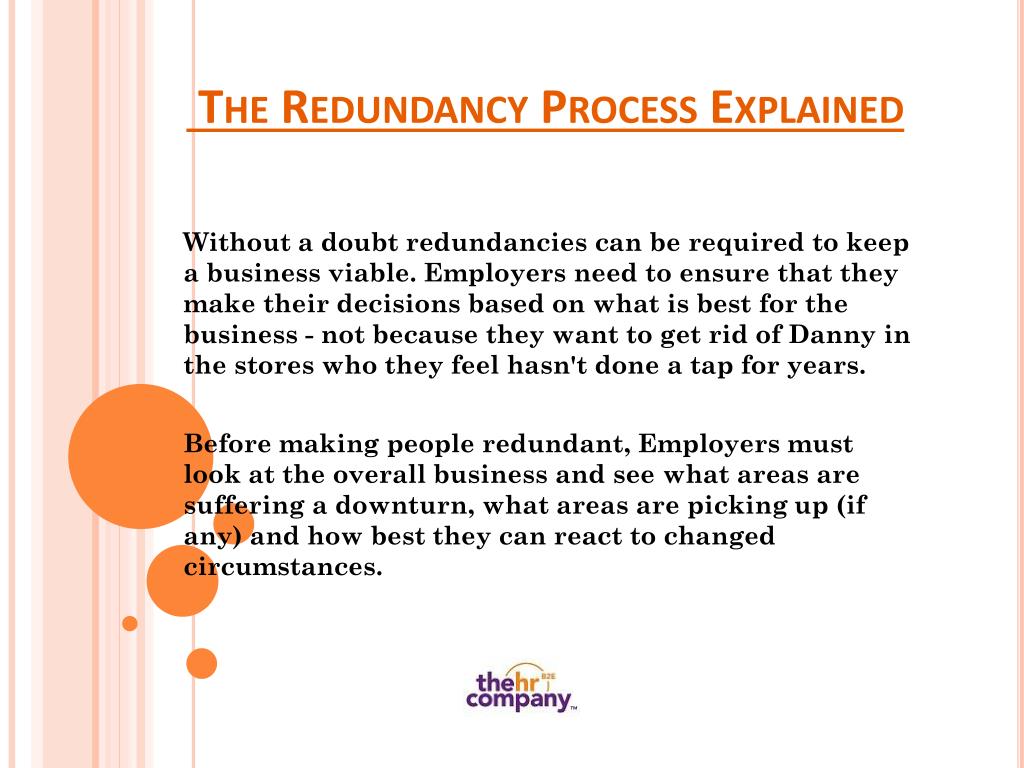Who Pays Redundancy Money? A Detailed Overview for Companies and Employees
Who Pays Redundancy Money? A Detailed Overview for Companies and Employees
Blog Article
Discovering the Operational Characteristics of Firm Redundancy and Its Long-Term Sustainability

Redundancy Approaches for Company Connection
In order to ensure uninterrupted procedures, organizations need to execute reliable redundancy strategies for business connection. Redundancy in this context describes the replication of essential elements or functions within a system to mitigate the influence of prospective failures. By incorporating redundancy approaches, companies can improve their strength versus interruptions triggered by various aspects such as all-natural catastrophes, devices failings, or cyber-attacks.
One usual redundancy method is the execution of back-up systems and information storage options. This involves developing matches of necessary information and systems that can be turned on in situation of a key system failing. Furthermore, companies can develop redundant communication networks and power resources to preserve connectivity and operations throughout unexpected events.
In addition, cross-training staff members to do several duties within the business can function as a useful redundancy strategy. This makes sure that crucial jobs can still be accomplished also if crucial employees are unavailable due to health problem or other reasons. Overall, effective redundancy methods are crucial for businesses to copyright functional connection and minimize the influence of prospective interruptions.
Impact of Redundancy on Organizational Resilience
Provided the crucial duty redundancy strategies play in guaranteeing company continuity, exploring the influence of redundancy on organizational strength comes to be imperative for understanding the alternative operational characteristics of a business. Redundancy, when tactically executed, can dramatically contribute to boosting an organization's resilience in the face of unexpected obstacles.
Furthermore, redundancy can cultivate innovation and imagination within a company as workers really feel encouraged to take computed dangers, recognizing that there is a security internet to sustain them in situation of failing. Generally, the impact of redundancy on business resilience is extensive, shaping the long-term sustainability and success of a firm.
Balancing Effectiveness and Adaptability in Redundancy
Attaining a harmonious equilibrium in between operational effectiveness and flexible adaptability is a pivotal difficulty in the strategic release of redundancy within companies. Effective operations are crucial for preserving productivity and cost-effectiveness, ensuring that sources are made use of optimally. However, too much emphasis on efficiency alone can result in strength, making it hard for companies to adapt to unexpected modifications or obstacles. On the other hand, flexibility permits companies to react nimbly to progressing conditions, promoting advancement and durability. Yet, way too much versatility without a strong functional foundation can lead to that site ineffectiveness and incongruity.
To stabilize effectiveness and adaptability in redundancy planning, companies must carefully examine their functional demands, market characteristics, and critical goals. Implementing lean methods can enhance efficiency by removing and improving processes waste, while cultivating a culture of useful reference versatility and continual enhancement can improve versatility. Additionally, buying cross-training programs and robust interaction networks can aid grow a flexible workforce with the ability of managing diverse tasks during periods of transition. Ultimately, finding the appropriate balance in between performance and versatility is critical for developing a durable and sustainable organization in the face of unpredictability.
Long-Term Sustainability With Redundancy Preparation
To make certain enduring practicality and stability, companies have to purposefully align their redundancy preparation with long-term sustainability objectives, therefore harmonizing functional effectiveness with flexible flexibility. Firms ought to see redundancy not as a reactive service to instant issues however as a proactive method for long-term success.

Positive Measures for Sustainable Company Procedures
Exactly how can companies proactively improve their operational sustainability for long-lasting success? Implementing positive actions is essential for business intending to ensure sustainable operations. One vital strategy is to invest in innovation and technology to simplify processes, minimize waste, and remain affordable in the market. Adopting lasting practices such as decreasing energy usage, lessening carbon footprint, and maximizing source utilization can not only benefit the setting however likewise result in cost savings over time.
Moreover, cultivating a culture of constant renovation and understanding within the company can boost flexibility to transforming market conditions and consumer needs. Motivating staff member involvement in decision-making processes and providing chances for expert development can boost morale, efficiency, and overall efficiency. Establishing clear goals, their website checking vital efficiency indicators, and frequently evaluating progression are essential parts of proactive sustainability management.
Working together with vendors, consumers, and other stakeholders to promote sustainable techniques throughout the supply chain can produce a causal sequence of positive influence - redundancy pay if company goes bust. By taking aggressive steps in the direction of operational sustainability, business can build strength, drive innovation, and safeguard their lasting success in an ever-evolving business landscape
Conclusion

In the realm of business administration, the strategic implementation of firm redundancy stands as a pivotal yet elaborate practice that requires a fragile balance in between operational efficiency and long-term viability. By studying the operational dynamics that underpin business redundancy and evaluating its more comprehensive effects for business strength and flexibility, a nuanced understanding of exactly how redundancy approaches can shape the future trajectory of a firm begins to unfold.Given the important duty redundancy techniques play in guaranteeing business connection, discovering the impact of redundancy on business strength comes to be imperative for comprehending the all natural operational dynamics of a business. On the whole, the influence of redundancy on organizational strength is extensive, shaping the long-lasting sustainability and success of a company.
In conclusion, understanding the functional dynamics of firm redundancy is important for guaranteeing long-lasting sustainability.
Report this page